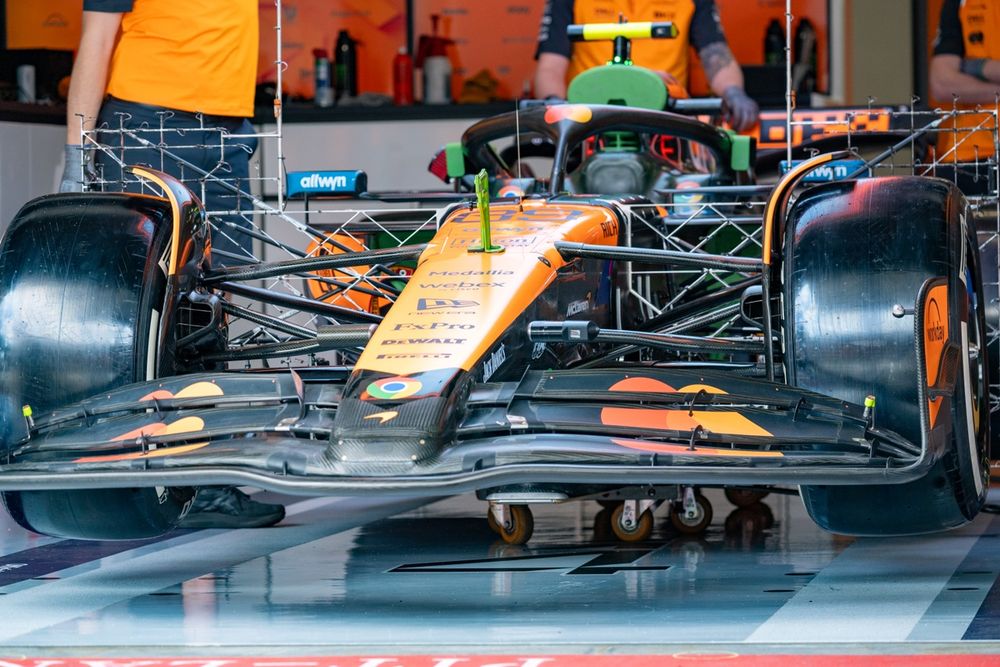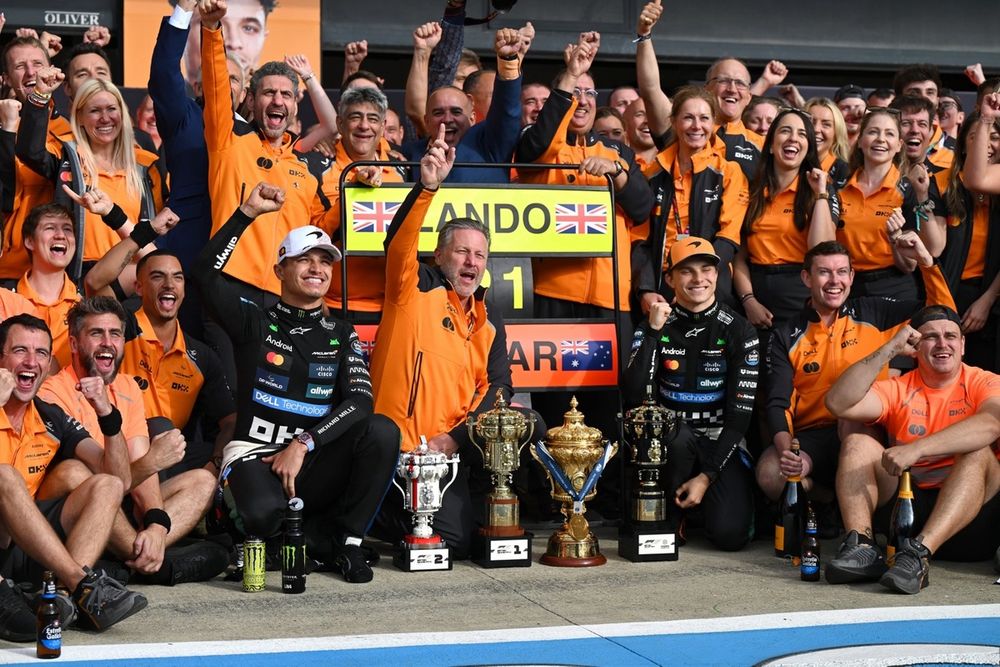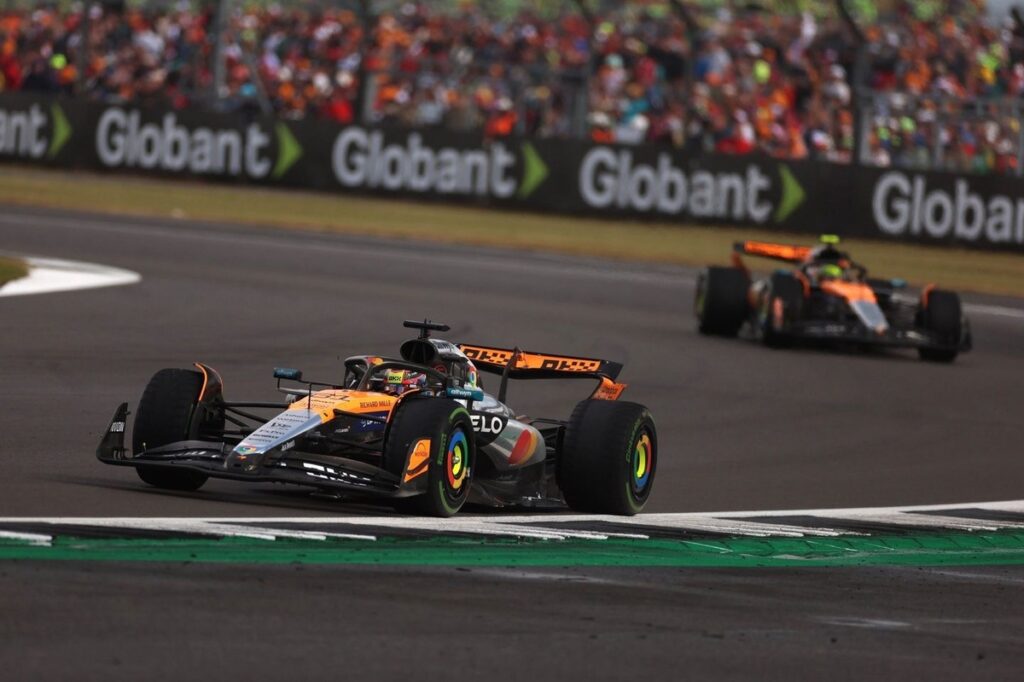During the British Grand Prix weekend at Silverstone, McLaren introduced a completely new floor, as noted in the FIA’s technical documents.
The squad ran it during opening practice, but team principal Andrea Stella made clear that the new spec would be removed afterwards. “The plan was always going to be that the floor was a test floor to have an early read on this new specification,” he said.
Ahead of second practice, McLaren switched back to the older version – one Lando Norris and Oscar Piastri secured another 1-2 with. Reverting to the older floor was by no means a sign that the new one didn’t live up to the team’s expectations, but simply part of the predetermined plan.
The new floor is expected to return during the Belgian Grand Prix weekend in Spa-Francorchamps, where it is set to be used in both qualifying and the races.
“The next race is a sprint event in which it’s more difficult to introduce a new specification and make proper comparisons,” Stella said, explaining the rationale behind testing it at Silverstone.
“We are actually pretty pleased with what we have seen during free practice in Silverstone. All the indications seem to lead us to introducing this new floor for the upcoming events.”
A sign of McLaren’s luxury position in F1 – different situation at Red Bull
Oscar Piastri, McLaren, Max Verstappen, Red Bull Racing
Photo by: Sam Bagnall / Sutton Images via Getty Images
McLaren’s approach with the new floor in Silverstone isn’t an isolated case. It’s far from the first time this season that the Woking-based team has brought upgrades to a track without immediately racing them.
In Canada, the papaya squad introduced a new front wing as a test item, only racing it later in Austria. Similarly, Norris had already tested the new front wing intended for Spain (to comply with the FIA flexi-wings TD) in Imola, and several more examples follow this pattern.
In all these instances, the delay in racing the new parts wasn’t due to underperformance, but rather to a carefully thought-out plan. By collecting on-track data, McLaren was able to verify the correlation, checking whether the upgrades delivered what was expected based on wind tunnel and CFD simulations.
This cautious rollout has helped McLaren avoid problems that have plagued other teams in recent years, such as correlation issues or unexpected side effects – issues Ferrari encountered after introducing a new floor in Barcelona last year, whereas Christian Horner has spoken many times about the handicap of Red Bull’s outdated windtunnel.
While McLaren’s approach to upgrades is wise, it also highlights the luxury it currently enjoys. If new parts offer a time gain and every tenth matters, why wouldn’t a team use it immediately?
The fact that McLaren can afford to take a measured approach shows just how comfortable its lead is, both on track and in the championship standings. That margin allows it to avoid unnecessary risks, while Red Bull was forced to roll out upgrades rapidly in hopes of salvaging its season.

McLaren MCL39, technical detail
Photo by: Circuitpics.de
In contrast, Red Bull debuted part of its new floor package for Silverstone (the floor edges) a race early in Austria – at least for Max Verstappen’s car. The midfield battle is even closer, meaning teams involved in that have no time to lose when it comes to bringing new parts to the car.
But with McLaren’s strong baseline, preserving that foundation matters more than squeezing out an extra millisecond a weekend early. McLaren has also been clever in adapting to the FIA’s technical directives.
It let Norris test the new front wing early to confirm that the FIA’s clampdown on flexi-wings wouldn’t hurt their performance from Barcelona onwards. These are the types of moves that are only possible when a team has a significant buffer – though, it still reflects smart planning from McLaren’s technical team, including Rob Marshall.
New floor set to return for F1 Belgian GP, rivals bringing upgrading as well
The Silverstone floor test fits neatly into this approach, with the full rollout planned for Spa. “The floor worked well, so we’ll be unwrapping that and throwing it on both cars,” said CEO Zak Brown. “It was always intended to just be a test part this first weekend, but we were happy with what we saw, so there is more to come.”
This naturally raises the question – and maybe even concerns among rivals: could the grid’s strongest car become even stronger?
“I think it’s more of the same,” Brown responded when asked about the Belgian Grand Prix. “Maybe not a 30-second win this time, but more of the same as far as how close it is.

Lando Norris, McLaren, Oscar Piastri, McLaren, Zak Brown, McLaren
Photo by: Sam Bagnall / Sutton Images via Getty Images
“I think all these races so far have been epic. Even though the numbers are 9 out of 12, every race is pretty stressful. So as long as they’re great to watch on TV… I hope we can do another 9 out of 12, but it’s an exciting season.”
While McLaren’s new floor could give it another edge, it’s worth noting that rival teams are also planning upgrades for Spa.
Ferrari is bringing a new rear suspension following a filming day in Mugello, while Helmut Marko told Autosport that Red Bull will introduce some further upgrades as well. These have been in the pipeline for a while and represent some of the final big pushes of the season, as teams have already shifted focus to the 2026 regulations.
All of this makes the Belgian Grand Prix an interesting one, despite the constraints of a sprint weekend.
One aspect remains: McLaren’s meticulous update strategy drastically reduces the likelihood of upgrades misfiring when they finally hit the track. That’s a luxury most other teams simply don’t have – and one of the clear advantages of McLaren’s current position.
In this article
Be the first to know and subscribe for real-time news email updates on these topics
Subscribe to news alerts
Read the full article here

